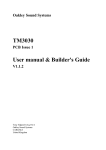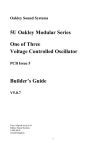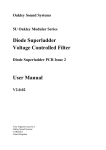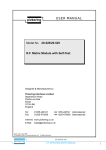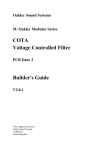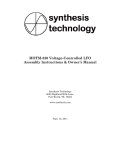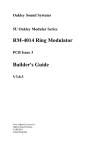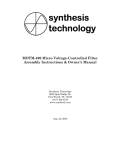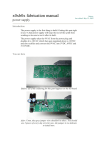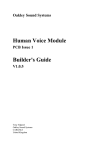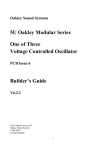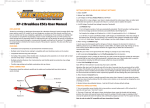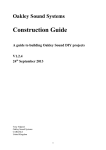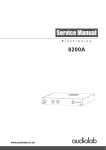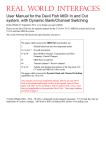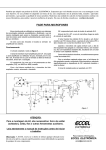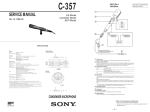Download TM3030 Builder`s Guide
Transcript
Oakley Sound Systems TM3030 PCB Issue 2 Builder's Guide V2.1.1 Tony Allgood Oakley Sound Systems CARLISLE United Kingdom Introduction This is the Builder’s Guide for the issue 2 TM3030 sound module from Oakley Sound. This document contains a basic introduction to the board, a full parts list for the components needed to populate the board or boards, and a list of the various interconnections, For the User Manual which contains an overview of the operation of the unit and the calibration procedure please visit the main project webpage at: http://www.oakleysound.com/tm3030.htm For general information regarding where to get parts and suggested part numbers please see our useful Parts Guide at the project webpage or http://www.oakleysound.com/parts.pdf. For general information on how to build our modules, including circuit board population, mounting front panel components and making up board interconnects please see our generic Construction Guide at the project webpage or http://www.oakleysound.com/construct.pdf. An issue 2 board awaiting its case and LEDs. This one has been built with a matched BC550B pair in the VCF and a CA3080 and discrete buffer for the VCA. 2 Parts Information For general information regarding where to get parts and suggested part numbers please see our useful Parts Guide which is linked from the TM3030 project webpage or direct at: http://www.oakleysound.com/parts.pdf. Some special considerations for this project I recommend to use a close tolerance polystyrene for the VCO timing cap, C9. This will give better pitch stability. Use a cheaper part if you can accept a small drift in VCO pitch with time. The PCB is laid out to accept the superbly specified 10nF LCR type EXFS/HR series. Standard axial polystyrene types will fit into the board if mounted on one end. The working voltage can be quite low, 63V is common. Other alternatives to polystyrene are polypropylene. But make sure you get low voltage types like 63V or so. Polypropylene capacitors are also used in suppression and can get very very big. The three ceramic capacitors should be ‘low-K', NP0, or C0G ceramic plates or dipped ceramics. The lead spacing is 2.5mm. I have also used some axial multilayer ceramics for the power supply decoupling on the digital sections. These parts can be substituted with ordinary low voltage radial polyesters if you wish. Watch out for the pitch spacing as the board is laid out to accept 0.3", 7.5mm, for these devices. The horizontal preset or trimmer resistors are just ordinary carbon types. No need to buy the expensive cermet types for these positions. Carbon sealed units have more resistance to dust than the open frame types. Piher make a suitable type to use here. Pin spacing is 0.2” at the base, with the wiper 0.4” away from the base line. The multiturn trimmers are the ones that have the adjustment on the top of the box. Spectrol and Bourns make these. Some types are 22 turns, while others are 25 turns. Either will do. They should have three pins that are in a line at 0.1” pitch. Don’t chose the 10-turn ones with the adjustment on the end, they won’t fit on the PCB. With the exception of the differential amplifier in the filter (Q36 & Q37) all the transistors shown as BC549 on the schematic can be pretty much any NPN transistor that corresponds to the same pin out. For example: BC550, BC548, BC547 etc. However, I recommend using BC549 or BC550 as these are low noise devices. A BC550 is actually just a BC549 that can operate at a slightly higher voltage. Quite often you see an A, B or C suffix used, eg. BC549C. This letter depicts the gain or grade of the transistor (actually hfe of the device). The TM3030 is designed to work with any grade NPN devices although I have used BC550B in my issue 2 prototype. 3 The PNP transistors shown as BC559 on the schematic should be high gain BC559C or BC560C types. The SCR in the VCO uses different transistors. Here I have used BC212L and BC182L. Although these are actually pretty ordinary transistors, they have a different pin out to the other NPN and PNP transistors used in the TM3030. They also have the same pin out as the Japanese parts used in the original device. You could substitute these three transistors with the Japanese parts if you can get them. The BC212L is equivalent to the 2SA733P, and the BC182L is equivalent to the 2SC536F. It is in my opinion that there are no sonic differences between the European and Japanese parts in this part of the circuit. The FET buffer of the VCO can be one of two parts. The PCB is laid out for both, but you must ensure the one you use goes into the correct place on the board. Q1 should be a 2SK30A-O. Q2 should be a J201. Do not fit both. The original design and my own TB3030 used the 2SK30A-0 but these are quite tricky to find. In the TB3031 I used the J201, and I still think this is a very good substitute for the Japanese part. In fact, it's possibly more accurate since the variation between any two J201 devices may well be less than that of any two 2SK30A-0. I will leave the choice of device to you. However, I have tested both parts in the TM3030 and recorded and compared the resultant audio output. I cannot tell the difference in the outputs from the two types. Q18 is also a 2SK30A-Y device. You should seek out this part if you want the envelopes to behave in the same way as the original. Y types are easier to get hold of than O types, and Senso at Vintage Planet should be able to supply you with one. As we have seen the original design used two variants of the 2SK30A, the O and the Y types. These two different types differ only by their value of Idss. This is the current that runs through the device when the gate and source are grounded and the drain is taken to 10V. The O types are defined as having a Idss of 0.6mA to 1.4mA. The Y types are defined as having Idss of 1.2mA to 3.0mA. Look at the range of Idss for the 2SK30A-O. It is interesting to note this, because the sound of the square wave is dependant on the Idss of the O type device. So no wonder that people have commented some TB303s sound slightly different to one another. The original Japanese NPN pair is the 2SC1583. It is a superb component and although not made any more it is still available from some places. Matched NPN pairs are required in three places in the TM3030, the exponential convertor, the filter ladder and the differential amp in the VCF. Only in the differential amplifier have I made space on the board to take the 2SC1583. In the other two positions I have used modern substitutes. For the exponential converter I have decided to use the easily available CA3083 in place of the 1583. There will be no sonic difference here and the CA3083 is more easily affixed to the temp co resistor used in our design. For the filter ladder the original design uses two matched pairs, one at the bottom of the ladder, a 2SC1583, and one at the top, a 2SC2291. Although the 2SC1583 is available, getting hold of the 2SC2291 is usually very hard. I didn't want to rely on builders getting this part so I have chosen the THAT300P which has been used successfully in the earlier TM3030 4 and Oakley Diode Superladder modules. The THAT300 is four very well matched NPN devices in one package. In my tests I found that this part sounds identical to the Japanese parts and is therefore an excellent substitute. THAT300P can be obtained from Profusion in the UK, Small Bear in the US, and also at Mouser (part #887-300P14-U). It is a good part and is somewhat expensive. The differential amplifier uses a single 2SC1583F in the original design. The TM3030 allows for this if you can get hold of the 2SC1583. If not, then do not worry, as the board can also be fitted with a hand matched pair of BC549B, BC550B, BC549C or BC550C transistors in positions Q36 and Q37. Again, like the FET in the VCO buffer either the two transistors or the 2SC1583 need to be fitted. Do not fit both U12, and Q36 and Q37. As stated, if you are fitting them, Q36 and Q37 should be a matched BC549B, BC550B, BC549C or BC550C pair. This means that both Q36 and Q37 should have identical characteristics. It is unlikely that two randomly picked NPN transistors will be exactly the same since the manufacturing process is not that precise. However, it is of my opinion that if both transistors are of the same type, eg. both BC550C, and are bought new from the same vendor and at the same time there is a very good chance that they will be matched well enough for this application. Modern fabrication methods are much better than they used to be. The VCA circuit also allows the builder some choice in the construction. The board is laid out to accept either the original R-Ohm BA662 OTA chip, or a my own VCA design based around the CA3080 OTA and a discrete buffer circuit. I have tested this part of the circuit very thoroughly, and I am convinced there is little or no perceivable audible difference in the two designs. It should be said that both OTA chips are now obsolete, but the CA3080 is still available from many sources. Small Bear and Senso both carry this part. In either case, do ensure that you build your choice correctly. The 3080 design uses an additional FET (Q35) and resistor (R118) and neither of these should be fitted if you are using a BA662. For the dual op-amps in the TM3030 I have specified the same parts as used in the original unit. These are AN6562 devices. They have a very large input voltage range, that includes zero volts, so they cannot be substituted with more common op-amps like the TL072. Alternatively you can use the LM358 instead. This is a good part and although it does behave slightly differently to the AN6562 in some conditions it does seem to not change the TM3030's sound in any way. The AN6562 devices are available from Senso for a modest amount. You need two of them, one for the VCO circuit, the other for the power supply. The PIC is a special programmed device that is supplied when you buy the PCB. Spare preprogrammed PICs, should you break yours, are also available for a small charge. Neither Sequentix or Oakley Sound will provide the firmware separately. 5 The other semiconductors used in the TM3030 are standard parts that you should be able to get from your local parts supplier. The PTC is a 1K +3500ppm/K positive temperature coefficient resistor. This means its resistance goes up with temperature. It's there to keep the VCO’s frequency relatively stable as the ambient temperature changes. The PTC I now use for this job is made by KRL in the US. They can be most easily obtained from Senso's Vintage Planet. They are described as 'Tel Labs Q81' equivalents and Senso's part number is: SC-R-118. Other PTCs do exist and good use can be had from the cheaper Meggitt series. Farnell part number 1174306. It's a 1K +3000ppm/K 900mW device. The old TB3030 used this part and I thought it was great until I tried the KRL parts. I can simply say that once fitted the KRL parts give much better stability over a wider range of temperatures. Input and output sockets are not board mounted. You can choose whichever type of sockets you wish. However, to reduce the possibility of earth loops you may be wise to use plastic sockets for the audio output socket. The LEDs can be any type, although I recommend the use of standard round 3mm types. You will need to bend their legs if you want them to stick through the panel. More detail about mounting the LEDs is given on this later on this document. Many manufacturers do ready made preformed LEDs in little plastic boxes. These may be perfect for the job, but be careful that your LEDs have the cathode on the right hand side as you look at the front of the device. The suggested colours for the LEDs are just that, suggestions. You can chose any colour you want for any of the LEDs. However, bear in mind some of the blue LEDs will appear brighter unless you step down the current with a bigger current limiting resistor. The front panel switch can be any style if you are not fitting it directly to the PCB. However, the PCB is designed to use the miniature toggle range from C&K. Ones made by Multicomp also fit very nicely. The switch should be an ordinary ON-ON switch, sometimes called SPDT. The C&K types are ‘type 2 horizontal’ non-sealed units. C&K’s part number is 7101MD9AV2BE. Farnell part number: 9575502. Multicomp switches are similar and can also be obtained from Farnell. The Multicomp part number is 1MS1T2B4M7RE. Farnell sell it as part number: 9473297. The power on switch will probably be fitted to the rear of the unit if you are using a half rack case or fitting two TM3030 units in one 1U rack. You can chose any type of switch you fancy, but I normally go for ones that need a circular mounting hole since these are easier to fit. The power inlet socket should be one to match your choice of wallwart supply. However, it is important that you chose an insulated design, ie. one made from a plastic housing. It is imperative that you do not let either of the input power leads connect to the chassis. Sometimes people like to substitute parts in place of my own recommendations. Feel free to do this, but remember that there is normally a good reason why I have selected that particular part. If you do find that, say changing an transistor with another one, makes an improvement, please do let me know via the Oakley-Synths list or our forum at Muffwigglers.com. 6 Parts List I strongly advise you to read the 'Parts Information' section above before you place any order for parts. For general information regarding where to get parts and suggested part numbers please see our useful Parts Guide at the project webpage or http://www.oakleysound.com/parts.pdf. A quick note on European part descriptions. To prevent loss of the small ‘.’as the decimal point, a convention of inserting the unit in its place is used. eg. 4R7 is a 4.7 ohm, 4K7 is a 4700 ohm resistor, 6n8 is a 6.8 nF capacitor. Resistors All resistors 1/4W 5% unless stated. 10R 22R 100R 220R 1K 1K5 1K8 1% metal film 2K2 2K2 1% metal film 3K3 1% metal film 3K9 1% metal film 4K7 5K1 1% metal film 6K8 10K 10K 10K 1% metal film 22K 47K 1% metal film 51K 1% metal film 68K 100K 1% metal film 100K 0.1% metal film 180K 200K 0.1% metal film 220K 1% metal film 220K 1M 1M5 R60 R65, R70 R88, R89, R113, R14, R61, R42 R1,R9,R10 R4, R117, R104, R84, R31, R64 R106 R85 R12, R29, R109, R112, R107, R110, R63, R44, R43, R94, R59, R58, R80 R91 R40 R50 R119 R38, R72 R74 R6, R13, R7, R116, R114, R100, R51, R97, R78, R77, R79, R57, R46, R83, R62, R67, R53 ,R52 ,R69, R68, R5 R118 - only if not fitting BA662 in U15. R71 R95, R11, R92, R93, R54, R41, R73, R66 R2, R96, R102, R39 R105 R56 R28, R8, R33, R108, R32, R35, R101, R103, R99, R115, R36, R37, R90, R30, R55, R75, R76, R82, R49, R47, R81, R120 R16, R18, R20, R22, R24 R3 R15, R21, R25, R26, R23, R19, R17 R27 R45, R98, R48, R86 R111, R34 R87 7 1K +3500ppm/K PTC - see text for mounting information. Capacitors 10nF 1% polystyrene 33pF ceramic plate 330p ceramic plate 3n3, 100V polyester 1nF, 100V polyester 10nF, 100V polyester 15nF, 100V polyester 33nF 100V polyester 47nF 100V polyester 100nF, 63V polyester film 220nF, 63V polyester film 330nF, 63V polyester film 100nF, 63V axial ceramic 1u0, 63V elect 2u2, 63V elect 10uF, 35V elect 22uF, 35V elect 47uF, 35V elect 470uF, 35V elect C9 C1, C2 C21 C30 C12 C11 C29 C41, C23, C28, C24 C32 C31, C6, C49, C47, C33, C34 C14 C56 C5, C7, C10 C37, C13, C55, C52, C19, C53, C51, C42, C46, C44, C35, C43, C15, C20 C22, C8 C54, C48, C27, C38, C36, C50, C17, C18, C25 C4, C3 C45, C26, C39, C40 C16 Discrete Semiconductors 1N4004 power diode 1N4148 signal diode BC182L NPN transistor BC212L PNP transistor BC550 NPN transistor BC550C NPN transistor BC560C PNP transistor J201 FET J201 FET 2SC1583 NPN pair 2SK30A-O FET 2SK30-Y FET CA3083 NPN array THAT300P NPN array D7, D6, D4, D3 D2, D14, D1, D5, D8, D13, D12, D10, D9, D11 Q5, Q4 Q3 Q34, Q9, Q10, Q27, Q8, Q26, Q7, Q20, Q19, Q21, Q15, Q14, Q29, Q30, Q24, Q25, Q12, Q17, Q23, Q13 Q36, Q37 - matched pair, see text. Q31, Q6, Q33, Q32, Q11, Q16, Q22, Q28 Q35 - only if not fitting BA662 in U15 Q2 - only if not fitting 2SK30A-0 in Q1 U12 - only if not fitting Q36 & Q37 Q1 - only if not fitting J201 in Q2 Q18 U6 U9 8 Integrated Circuits 4050 hex non-inverting buffer U5, U4 4066 quad analogue switch U8 6562 or LM358 dual op-amp U7, U13 6N137 opto coupler U2 LM723 voltage regulator U10 78L05 +5V regulator U1 BA662 Roland OTA U15 - fit only if not fitting CA3080 in U14) CA3080 OTA U14 - fit only if not fitting BA662 in U15) PIC18F242 TM midi-chip U3 - supplied with PCB Trimmers 2K multiturn cermet 10K multiturn cermet 50K multiturn cermet 470K horizontal carbon PSU V/OCT PITCH FREQ, OFFSET Pots All Alpha 16mm types with seven matching brackets. Note Alpha and ALPS use A and B suffixes on their pot values. A = log and B = linear. 1M log 50K lin 50K lin x 2 (dual gang) 50K log DECAY TUNE, ENV_MOD, FREQUENCY, ACCENT RESONANCE VOLUME Miscellaneous 4.000MHz crystal 5-pin DIN socket 1/4" jack socket 2.5mm power inlet Power switch LED 3mm red LED 3mm green LED 3mm yellow SPST toggle switch Knobs X1 - see text for mounting information. MIDI_IN, MIDI_OUT AUDIO_OUT AC_POWER SLIDE, ON GATE ACC WAVE Seven off to suit pot shafts Also you will need solder, connecting wire of some sort and a case to put it all in. You may want to use IC sockets for all the ICs. I do recommend that you use an 28-pin 0.3" wide IC socket for the PIC. 9 Populating the TM3030 PCB For general information on how to build Oakley projects, including circuit board population, mounting front panel components and making up board interconnects please see our generic Construction Guide at the project webpage or http://www.oakleysound.com/construct.pdf. There are a few things I ought to draw your attention to that are not covered in the Construction Guide. 1. The 4MHz crystal case is larger than the issue 2 PCB is laid out for and fitting it will foul the neighbouring ceramic capacitors. You must therefore fit C1 and C2 first. X1, the crystal, is then soldered in place so that the base of the crystal's casing is resting on the top of the two ceramic capacitors. Although this is not a standard way of mounting the crystal it will not cause any problems to do so. 2. The positive temperature coefficient (PTC) resistor is mounted so that is lies across the top of U6. This is to ensure that both it and U6 are at the same temperature so that the resistor can compensate for the temperature dependency of the VCO control circuitry. A close up of the VCO circuitry of the TM3030. Note the positioning of the positive temperature coefficient (PTC) resistor. Although not used here, a small amount of thermal paste can be used to keep both U6 and the PTC at the same temperature. 10 3. If you are not fitting a 2SC1583 to the filter circuit then you need to use a matched pair of BC550B or BC549B transistors. In theory these should be perfectly matched and thermally bonded together. One way of thermally connecting them is to tie them together with a cable tie as seen in the photograph below. Two BC550B transistors face to face and fixed together with a simple cable tie. Again, a small amount of heat conducting paste can be used if desired. 11 Mounting the Pots, LEDs and Switches If you are using the recommended Alpha pots, then they can support the PCB with specially manufactured pot brackets. You will not normally need any further support for the board. When constructing the board, fit the pot brackets to the pots by the nuts and washers supplied with the pots. Now fit them into the appropriate holes in the PCB. But only solder the three, or six, pins that connect to the pot. Do not solder the pot bracket at this stage. When you have soldered all the pots you can fit the board to your front panel. Position the PCB at right angles to the panel, the pot’s own pins will hold it fairly rigid for now. Then you can solder each of the brackets. This will give you a very strong support and not stress the pot connections. The Alpha pots are labelled with an A or B suffix. For example: 50KB or 1MA. Alpha and ALPS do the opposite to our European convention and use A = log and B = linear. So a 1MA is a 1 megohm log pot. The four front panel mounted LEDs must be fitted carefully if you are using the directly mounted technique. Although this sounds fiddly, it's actually quite easy and it reduces wiring, interference and possible errors. A close up of the LEDs in a 19” rack mounted issue 1 TM3030. You can see that the LEDs simply poke through the front panel. Remove the front panel so that you just have the board again. Get the four LEDs and find the cathode for each one. Make sure the cathode of the LEDs will go into the round pad, pin 2, on the board. Carefully bend the LED’s legs at a point 6mm away from the plastic body of the LED. The legs should be bent by 90 degrees so that the legs are pointing straight down. Check to see if they fit into the board. The bottom of the LED’s body should fit just flush to the board edge. Fit all four LEDs to the board but do not solder them in at this stage. Let their legs poke through, there’s no need to cut them down yet. Now fit the front panel again to the board and tighten the pot nuts. You should find that the board now fits snugly into position 12 and each LED should be just poking out of its hole neatly, albeit loosely. Align the LEDs if they aren’t quite straight and solder each one in turn, trimming its leads nice and short afterwards. With panel removed once again, you can now fit the switches. The C&K PCB mountable switch should fit tightly into its respective holes on the board. You may need to use a pair of fine nosed pliers to help the flexible gold pins into the board holes. Make sure the switch body is flat against the board. Now refit the front panel and make sure the round switch barrel fits into its hole in the front panel. Now solder all the pins on the switch including the securing pins to the front. That completes the soldering of the front panel components. 13 Housing your unit The PCB has been designed to fit into a standard 1u high 19” rack or half rack unit. Your local parts distributor should have these. However, good rack units can be quite expensive and will contribute heavily to the final cost of your completed TM3030. Expect to pay around 40GBP or so. Your choice of case will also be affected by what else you want in your enclosure. It is possible, in theory at least, to fit two TM3030 units side by side in a 1U rack case. This does depend on the rack case you have chosen, but most should have the front panel space to allow this. If you are choosing to use an internal mains supply, make sure you give yourself enough room for the transformer and associated wiring. In the UK Bryant Broadcast, Holt Broadcast Services, Electrospeed and RS Electronics Ltd do have a range of rack units that may be suitable. The Bryant and Holt Broadcast ones are both superbly made, but they do not allow you to use the standard 3mm thick Schaeffer front panel. Their cases utilise the front panel as part of the enclosure. Simply swapping the Bryant/Holt panel with one obtained from Schaeffer will not work. Of course, if you are drilling out the Bryant/Holt panel to any Schaeffer plan, then this would indeed work wonderfully. Both Bryant and Holt do custom metal work, so it may be possible to try their services. This is one area I would like to try in the near future. Another option is to send the plain Bryant or Holt front panel to Schaeffer for engraving. Contact Schaeffer for details of this service but don't expect it to be cheap. If you buy the cases made by Vero from Farnell and others, you will find that the height of the unit internally is quite restricting. The bottom and lower panels have 6mm folds in them at the front. This effects the amount of space available for the pots and circuit board at the front panel. It is possible to use these cases as I have done in the past, but I needed to cut back the three pins on each pot to prevent them shorting with the case. The pot bracket pins actually prevent the case from then touching the pot’s pins. This is all right, but you really need to allow a minimum of 0.5mm slack when you fit the front panel to the case. The second issue 1 TM3030 I built. This one has been built into a 19” rack from Holt Broadcast. The front panel legending is achieved with a perspex overlay. The other choice is to fit the TM3030 into a half rack. My first issue 1 TM3030 prototype was built into a half rack width two tone metal case from RS Components Ltd. Their part number is 222-020. Unfortunately, you will need to do some rework on the internal bracketry to allow 14 the board to fit in without fouling the side supports. The nice thing about these cases is that although the main surrounding is made from steel for strength, the front panel is made from folded aluminium and so is easy to cut and shape holes. My first issue 2 TM3030 fitted into the three part metal case from RS Components (pt no: 222-020). I should point out that the best performance will always come from using metal cases. Metal cases are not only more rugged but they also provide screening. A good grounded case will protect the TM3030 from extraneous radiation from CRTs, amplifiers and computers. The TM3030's VCO is particularly susceptible to mains hum fields. Although the PCB layout is carefully done to minimise this, if you fit your unit into a plastic or wooden case, you may find that you will get a little 100Hz or 120Hz wobble in the unit's pitch. You can use some aluminium foil to shield the circuitry, this can be stuck down on the lower part of the case, underneath the PCB, and connected to the GND pad of the TM3030. Do not connect your screening to any lug of the power pack inlet socket though. When using any metal case it is essential that the case is grounded so that the screening is most effective. Grounded means electrically connecting the metal case to the 0V or ground of the circuitry. The GND pad provides a handy point from which to wire your panel's metalwork to. However, you will probably not need to use the GND pad at all if you have used metal midi sockets or a jack socket with a metal bush. See the chapter on midi, power and audio connections for more details on this. 15 For those of you fitting an internal toroidal transformer you must make sure there is no way the bolt that secures the transformer can touch both the bottom and top of the metal case. If the metal support of transformer together with the case makes a complete loop around the core, then you have a shorted one turn secondary. (‘Well, there was a large hum, more of a buzzy rattle really, then a smell of burning rubber and then a lot of smoke... ’). You may also like to consider the use of a nylon bolt to hold the transformer in place. When an internal transformer, toroid or otherwise, is being used then the metal case must be connected securely to earth. This is best done with a M4 bolt, nut, toothed washer and solder tag directly wired (with thick wire) to the IEC inlet socket's earth tag. The TM3030's circuitry should be then tied to earth via another wire from the GND pad on the board back to the bonding point. There is little more information about using internal mains transformers later in this document. I should stress that building a component level mains transformer into any DIY project should not be taken lightly as the consequences for getting it wrong can be severe. The PCB will be supported well enough by the pots and pot brackets. However, this may give some people nightmares so it for them it will be a good idea to provide additional support. Small holes, to fit M3 bolts, have been provided on the outer corners of the PCB to do this. Feel free to enlarge these holes if you wish. My prototype has been very happy just supported by the pots. However, my unit doesn’t get moved around much. If you intend to take it out on the road, extra support may be a good idea. 16 Midi, Power and Audio Connections The prototype had its input and output sockets mounted on to the PCB itself. This initially seemed quite practical, but in reality would only be useful if everyone was going to be using the same casing. In the production run we have used 0.1" headers for all the I/O connections. This should give you more flexibility in making your unit suit your own needs. The TM3030 board will be held in place in the case either by the pot brackets or the four mounting posts. The sockets should then be mounted onto the rear panel and then hand wired to the PCB. 0.1" headers are commonplace on commercial units to speed up manufacture. You can use either Molex [strip and crimp] or MTA [insulation displacement] type connectors. For those who haven't a clue about either of these forms, it is probably best for you to just to solder the connecting wires in place. 0.1" headers are useful and easy to use, but both types require special and relatively expensive tools to make up the wiring. So, for many of you it will be easier to simply solder the wires into the correct holes on the TM3030 PCB. The type of wire is often asked about on the forum. I use multistrand hook up wire and this often comes in hobbyist packs of varying colours. The size that I use is typically described as 7/0.2mm which is seven strands of 0.2mm diameter wire. Don't use single strand wire since this tends to break easily. Remember to keep all wires as short as you can, but allow for a little extra so that no wire will ever become taut. I usually tin the bare wire ends with a bit of solder before I place the wire into the board or terminal hole. This stops the wire end from fraying and makes a better solder joint. NOTE: Pin 1 of the headers are denoted by a square solder pad on the PCB. All the others are round. You have just four sockets to wire up and it doesn't take long at all. Lets deal with the power inlet first. You'll probably want to include a power switch, but this isn't shown on any of the schematics. If you have chosen a nice SPST switch, it will only have two terminals. Simply wire this in series with one of the connecting wires from the power inlet to the PCB. If you are using a metal case then the power inlet socket should not have a metal mounting bush. That means that it should not have any metal part on main body of the socket touching the TM3030's metal case. We do not want any direct connection from the power supply's wiring to connect to the case. The power inlet socket has two or three terminals. The ones you need are the terminals that connect to the the inserted power plug. The third terminal is the 'normally closed' lug, sometimes called the NC or normalising lug. This should be ignored in our application. The header labelled AC_POWER will connect to the power inlet and the power switch. Pin 1 of AC_POWER should go to any terminal on the switch. Pin 2 should go to any of the two terminals on the power socket that are not the NC lug. You should connect the other terminal on the switch to the other terminal on the power inlet that isn't the NC lug. Remember the TM3030 uses a bridge rectifier on its power input, so it doesn't matter about the polarity of the input voltage. 17 The next socket we shall wire up is the audio output. This should be a 1/4" jack socket and you can use either plastic framed sockets (with a plastic securing nut) or ones with a metal bush (and metal securing nut). Both types will probably have three lugs, but may have six or just two. You will be connecting only to the terminals that will connect to the tip and sleeve of the connected jack plug. Connect pin 1 of AUDIO_OUT to the terminal that will connect to the tip of the jack plug. This wire will carry the audio signal. Connect pin 2 of AUDIO_OUT to the terminal that connects to the sleeve of the jack plug. This is the 'earth', or ground, of the signal. Now if you have used a socket with a metal bush and securing nut and have a metal case then the jack socket will have grounded your case. By grounding your metal case you will help screen the internal circuitry from outside electrical interference. To help make a good connection with the case it is best to use a toothed or sprung washer between the socket and the inside of the case. If you have a plastic output socket do not worry you'll be grounding your case with the midi sockets. A close up of an older issue 1 TM3030 showing the midi connections done with Molex KK 0.1” headers and housings. Issue 2 boards can be wired in a similar way. Wiring the midi sockets often causes the most confusion since it's sometimes difficult to know which pin goes to where. Midi sockets are numbered in a most confusing way. If you get this wrong the TM3030 won't be damaged, but it will not operate correctly. 18 When you look at the back of a midi socket, you will see six terminals. If you are lucky then they will be labelled, but quite often they are not. We will firstly consider the five of them that form a half circle. If you position the socket so that the middle terminal is at the top, then the pin numbers go 3, 5, 2, 4, 1. Pin 2 is therefore at the top. The sixth terminal is normally opposite to pin 2 and connects to the metal surrounding of the socket. We shall call this pin the 'sleeve' pin. x2 x5 x3 x4 x1 x Sleeve The midi sockets are wired up as follows: MIDI_IN Pin 1 on PCB goes to Pin 4 on socket Pin 2 on PCB goes to Pin 5 on socket MIDI_OUT Pin 1 on PCB goes to Pin 4 on socket Pin 2 on PCB goes to Pin 2 on socket Pin 3 on PCB goes to Pin 5 on socket If you have used a plastic audio output socket then you should also connect pin 2 on the midi output socket to the sleeve solder tag. This can normally be done with a small length of solid core wire on the socket itself. By making this connection you will have connected the metal case to 0V (ground) and screened your case. If you have used plastic midi sockets, or have metal ones with no sleeve connection, along with a plastic output socket you will have to ground your case another way. Drill a 3mm hole into your metal case at the rear. Fit an M3 screw through this hole and with a nut, toothed washer and solder tag create a grounding point on the inside of your case. Then connect a wire from this grounding point to the GND pad on the TM3030 PCB. That completes the wiring of the TM3030. 19 Fitting an Internal Mains Transformer I do not endorse, nor recommend, any method that uses the direct powering of any Oakley equipment with the mains supply. It is up to you to use your PCB wisely and to make sure you make your project in a safe manner. Furthermore you should ensure that the finished project is safe to any persons who are using it. Oakley Sound Systems cannot take any responsibility for your actions with this board. The following advice is only for those who know how to wire mains rated equipment safely. If you do not know how to do this then make no attempt to do so. The following information, provided in italics, is the only information I am prepared to give regarding direct mains supply for the TM3030. Transformer rating: Secondaries: 15-0 or 7.5-0-7.5 @ 3VA minimum Do not connect the common of any dual secondary windings to ground. Winding end wires go to pin 1 and pin 2 of the connector marked AC power. Neither pin 1 or pin 2 should be connected to ground. C16 should be adequately rated for the input voltage you are using. ie. At least equal to 1.4xVac. Where Vac is the maximum output RMS voltage of the transformer. Line fuse: T250mA All mains carrying conductors must be suitably insulated and mounted away from the low voltage parts of the unit. All parts of the metal case MUST be connected to mains safety earth. A suitable and secure bonding point must be made to the case. Note that any case paint or other coating should be removed from around the bonding point to ensure that the metalwork is making a good contact to the bonding point hardware. The bonding point should then be connected via a suitably thick piece of wire back to the earth terminal of the IEC socket or earth inlet connection. If you have used a laminated EI transformer, ie. not a toroid, then you should earth the exposed metal frame of the transformer. 0V on the TM3030 circuit board should also be tied to earth. This should be done using a piece of insulated wire connecting the earth bonding point to the GND pad on the board. In this instance only it will be preferable to use a plastic audio jack socket and not connect the sleeve of the midi output socket. 20 Final Comments If you have any problems with the module, an excellent source of support is the Oakley Sound Forum at Muffwiggler.com. Paul Darlow and I are on this group, as well as many other users and builders of Oakley modules. If you can't get your project to work, then Oakley Sound Systems are able to offer a 'get you working' service. If you wish to take up this service please e-mail me, Tony Allgood, at my contact e-mail address found on the website. I can service either fully populated PCBs or whole modules. You will be charged for all postage costs, any parts used and my time at 25GBP per hour. Most faults can be found and fixed within one hour, and I normally return modules within a week. The minimum charge is 25GBP plus return postage costs. If you have a comment about this user guide, or have a found a mistake in it, then please do let me know. But please do not contact me or Paul Darlow directly with questions about sourcing components or general fault finding. Honestly, we would love to help but we do not have the time to help everyone individually by e-mail. Tony Allgood at Oakley Sound Cumbria, UK © July 2011 – updated December 2012 21





















